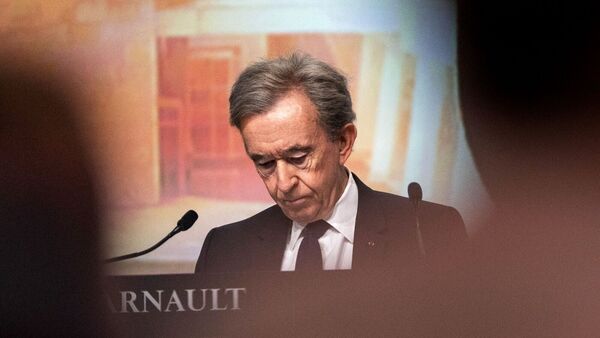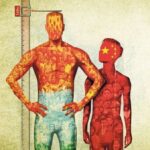The LVMH group owns some of the world’s best-known luxury brands, including fashion houses Dior, Givenchy, Christian Lacroix, Celine, Fendi and Marc Jacobs – and of course, Louis Vuitton, which became the world’s first $10 billion luxury brand in 2018 and has seen revenues double in the past four years. (Louis Vuitton’s menswear designer, Grammy award winner musician Pharrell Williams, will present his first clothing collection in Paris in June.)
Arnault built the luxury powerhouse with serial buyouts, including that of US jeweller Tiffany for $15.8 billion in 2020 – one of his most successful acquisitions. The portfolio has more than 75 brands, including watchmaker TAG Heuer, jewellery line Bulgari, and beverages brands Dom Pérignon (champagne), Hennessy (cognac), and Glenmorangie (whisky).
The group also owns the historic Paris department store Le Bon Marche, the famous Hotel Cipriani in Venice, and a range of hotels with Michelin-starred restaurants called Cheval Blanc in Courchevel in the French Alps.
Another prized possession is La Samaritaine, the heritage department-store chain that started in 1870 as a small clothes store. Sustained financial losses and safety issues in the original store’s building, located across from the Louvre in Paris (which often hosts LV fashion shows), forced a shutdown in 2005. Arnault bought and redeveloped it, restoring its art-nouveau façades and cast-iron signs, and added to the site a Cheval Blanc hotel, 96 low-cost housing units, and office space.
Arnault and his family – his five children work at LVMH and there is speculation over who will succeed him – hold 48% of the company’s shares. His personal fortune is estimated at just under $200 billion, and includes properties across the world, a private island in the Bahamas, and an art collection that includes an early 20th-century depiction of Charing Cross Bridge by Claude Monet, and works by Jean-Michel Basquiat, Damien Hirst, Maurizio Cattelan, Andy Warhol and Pablo Picasso.
His wealth first exceeded Bezos’s on December 16, 2019, albeit for all of five hours, when LVMH’s stock rallied in response to the Tiffany deal.
Comparisons are often drawn between Arnault’s acquisition of Tiffany with Musk’s buyout of Twitter. Both overpaid, but Arnault’s purchase has proved savvier. After failing to acquire Gucci and Hermès, he set his eyes on Tiffany. LVMH made an unsolicited offer for $120 a share in 2019 and closed the deal at $135 a share, or $16.2 billion, a 37% premium to the stock price and nearly 17 times the luxury jeweler’s earnings before interest, tax, depreciation and amortisation (Ebitda).
The Covid-19 pandemic in early 2020 gave Arnault second thoughts. He backtracked, which led to lawsuits in Delaware. The re-negotiated deal was closed a few months later, with LMVH agreeing to pay $15.8 billion, a face-saving reduction of $420 million on the original offer price.
But luxury-goods sales jumped during the pandemic and the acquisition proved a hit. Tiffany turned in higher revenue and profits and its cash flow increased, too.
The pandemic lockdowns, it was initially feared, would hurt luxury sales in the US and China, the biggest markets for luxury goods. But customers’ appetites proved resilient and the draw of the brands irrepressible, and LMVH reported record profits in both 2022 and 2023.
In France, the affluent exert influence and power through ownership in the media. LVMH owns the daily newspaper Le Parisien, a classical radio station, and France’s largest business newspaper, Les Echos, which it bought in 2007 from Pearson, the erstwhile owner of the Financial Times.
Arnault is from the French city of Roubaix, near the Belgian border, where he was born in 1949. He graduated in 1971 from France’s most prestigious engineering school, which counts three Nobel laureates and Carlos Ghosn, the former chairman and CEO of Renaul, among its alumni. His father owned a civil engineering company and later ran a real estate business which Arnault took over after his death.
Dior perfumes fascinated his mother, he told an interviewer once. She made him take piano lessons, and he is said to have played French composer Chopin’s etudes to Canadian concert pianist Hélène Mercier, his second wife, during their courtship.
The luxury magnate also courts controversy from time to time. Recent protests against President Emmanuel Macron’s unpopular plan to raise the retirement age as a way of dealing with the deficits in France’s state-run pension system have featured placards bearing Arnault’s face amid calls for higher taxes on France’s billionaires.
He drew ire for trying – unsuccessfully – to acquire Belgian nationality after France’s 2012 budget looked set to heavily tax the wealthy. Earlier, he had moved his family and business to the US in 1981 in response to the French Socialists’ tax-the-rich agenda. He returned to France in 1983 to take over the iconic but bankrupt Boussac, which comprised a number of fledgling businesses. Of these, he has retained only a few, including Dior.
That is also when he then started picking up shares of LVMH, the merged company of brands Moet Hennessy and Louis Vuitton, soon becoming its largest shareholder. He quickly acquired a reputation for ruthlessness – and the sobriquet ‘the wolf in cashmere’ – for ousting LMVH’s top executives in subsequent tussles.
Download The Mint News App to get Daily Market Updates.
More
Less
#Bernaud #Arnault #built #luxurygoods #empire #worlds #richest #person



